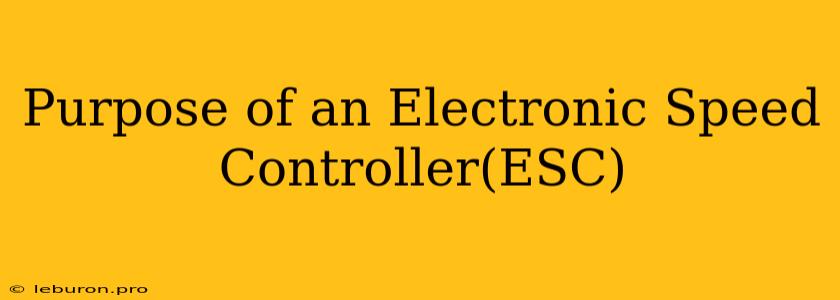An Electronic Speed Controller (ESC) is a vital component in the world of radio-controlled vehicles, particularly electric-powered models. Its primary function is to act as an intermediary between the battery and the motor, managing and controlling the power flow. This allows for precise regulation of motor speed, direction, and braking, giving users a high degree of control over their vehicles. This article delves into the purpose of an Electronic Speed Controller (ESC), exploring its key functions, working principles, and significance in various applications.
The Fundamental Role of an ESC
At its core, the Electronic Speed Controller (ESC) is a sophisticated electronic device that facilitates the safe and efficient operation of an electric motor within a radio-controlled model. It serves as a bridge between the battery, which provides power, and the motor, which transforms electrical energy into mechanical motion. The ESC's primary function is to regulate the amount of current flowing to the motor, thereby controlling its speed and direction.
Key Functions of an ESC:
- Speed Control: An ESC allows users to adjust the motor's rotational speed by varying the amount of power delivered to it. This fine-tuning of speed is crucial for various applications, such as adjusting the pace of a car on a racetrack or controlling the ascent and descent of a drone.
- Direction Control: For vehicles equipped with reversible motors, the ESC enables switching between forward and reverse motion. This is achieved by altering the polarity of the electrical current supplied to the motor, effectively changing its direction of rotation.
- Braking: Many ESCs provide braking functionality. This is accomplished by reversing the motor's polarity, creating a braking force that slows the vehicle down or brings it to a complete stop. This feature is particularly important in applications where precise control is required, such as in off-road racing or maneuvering in tight spaces.
- Protection: ESCs are designed to protect the motor and battery from damage. They can sense overcurrents and overheating conditions, automatically shutting down the power supply to prevent damage to the components.
Understanding the Working Principles
The Electronic Speed Controller (ESC) operates based on the principle of pulse-width modulation (PWM). PWM involves rapidly switching the power supply on and off at a high frequency. The duty cycle, the ratio of "on" time to "on" plus "off" time, is adjusted to control the average power delivered to the motor.
How PWM Works:
- Signal Reception: The ESC receives commands from the radio transmitter, which instruct the ESC to increase or decrease the motor's speed or change direction.
- Signal Conversion: The ESC converts these signals into PWM signals, which are basically electronic pulses with varying widths.
- Motor Control: The ESC sends these PWM signals to the motor, effectively modulating the amount of current flowing to it.
- Speed Adjustment: By adjusting the duty cycle, the ESC can increase or decrease the average power delivered to the motor, thereby controlling its speed.
- Direction Control: To change direction, the ESC simply reverses the polarity of the PWM signal.
Application of ESCs in Various Fields
The Electronic Speed Controller (ESC) is a versatile device with applications in various fields, including:
- Radio-Controlled Vehicles: ESCs are a fundamental component in all types of radio-controlled electric vehicles, from cars and trucks to drones and airplanes. They enable precise control over speed, direction, and braking, enhancing the overall performance and handling of these vehicles.
- Robotics: ESCs play a critical role in robotics applications, enabling the precise control of motors driving actuators and robotic limbs. This allows for intricate movements and precise control in complex tasks.
- Industrial Automation: ESCs are used in industrial automation to control motors in conveyor belts, robots, and other machinery, ensuring smooth and efficient operation.
- Electric Vehicles: While not used in the same way as in RC vehicles, ESCs are a key part of the electrical system in electric vehicles. Their principles are applied to the electric motor controller, which manages power flow from the battery to the motor.
Conclusion
The Electronic Speed Controller (ESC) is an indispensable component in the operation of electric motors in various applications. Its ability to control speed, direction, and braking, combined with its protective features, makes it a vital part of the systems it is used in. As technology advances, ESCs are becoming more sophisticated, incorporating advanced features like regenerative braking and sensorless operation. Understanding the purpose of an ESC is essential for anyone working with electric motors, whether in the field of radio-controlled vehicles, robotics, industrial automation, or electric vehicles.
